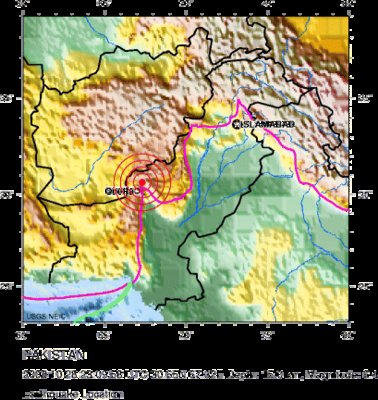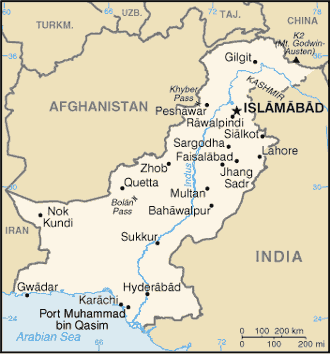
by Carolyn Gramling Thursday, January 5, 2012

Wednesday's earthquake struck about 60 kilometers northeast of Quetta, in Pakistan's Baluchistan province. USGS Earthquake Hazards Program

USGS Earthquake Hazards Program
A magnitude-6.4 earthquake rocked through southwestern Pakistan just after 4 a.m. local time Wednesday, killing at least 170 people and leaving about 15,000 more homeless. That quake was followed by a second magnitude-6.4 quake at 4:30 p.m. local time.
The tremors originated about 60 kilometers north-northeast of the town of Quetta in Baluchistan province. Mountainous Pakistan sits squarely on the tectonic collision zone between India and Eurasia. India's northward drive into Eurasia, which built the Himalaya Mountains, "crumples the region," says Paul Earle, a seismologist with the U.S. Geological Survey's Earthquake Hazards Program. Due to the region's highly complicated tectonics, sorting out which faults may have slipped in the most recent earthquake will be difficult, Earle says. "The area is so faulted; it will be hard to pin down to a named fault."
Pakistan experiences the most frequent earthquakes in its mountainous regions to the north, near Kashmir, and to the west, where Quetta is located. Quetta is also the headquarters of the Geological Survey of Pakistan, which reported that the epicenters of both of Wednesday's quakes were shallow, between 10 and 15 kilometers deep. For earthquakes of similar magnitudes, shallower earthquakes can cause more shaking and do more damage than deeper earthquakes, because less distance to travel to the surface means less attenuation of the quake's energy, Earle says.
Quetta has suffered through other deadly earthquakes in historical times: In 1935, a magnitude-7.5 earthquake struck the region, killing 30,000 people. But Pakistan's most deadly recent earthquake occurred in the northern part of the country on Oct. 8, 2005, when a magnitude-7.6 earthquake rocked through a region about 105 kilometers northeast of Islamabad. That quake killed 86,000 people and left 350,000 homeless.
The region around Quetta experienced "violent" shaking during Wednesday's temblors, equivalent to heavy structural damages, according to USGS. USGS estimates ground shaking intensity — how powerfully people and structures will experience the earthquake — based on the quake's magnitude, the depth of the epicenter and the softness of the soil. But other factors figure into structural damages and deaths, such as building resistance to shaking. Pakistan's mud-daubed buildings tend to be highly vulnerable to earthquake shaking, Earle says. "The Northridge, Calif., earthquake in 1994 shook as many people at the same high intensities [as the 2005 Pakistan earthquake], and there were less than 100 people killed."
© 2008-2021. All rights reserved. Any copying, redistribution or retransmission of any of the contents of this service without the expressed written permission of the American Geosciences Institute is expressly prohibited. Click here for all copyright requests.